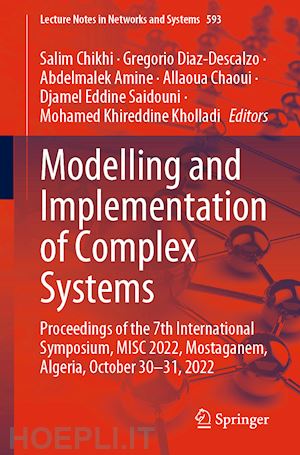
Questo prodotto usufruisce delle SPEDIZIONI GRATIS
selezionando l'opzione Corriere Veloce in fase di ordine.
Pagabile anche con Carta della cultura giovani e del merito, 18App Bonus Cultura e Carta del Docente
The breakthrough of AI in the design of complex systems in our daily lives has prompted researchers around the world to integrate this paradigm into their work. From simple citizens to large industrialists, including academics and politicians, there is a great enthusiasm for making all objects intelligent. This has led the scientific community to develop complex intelligent systems adaptable to different real-life systems. This book, which is a selective collection of research papers accepted by the international program committee of the 7th international symposium on Modeling and Implementation of Complex Systems (MISC 2022), makes its contribution in this vast field and addresses subjects that are as interesting as they are useful to the citizen life, namely
In healthcare: health monitoring systems for heart patients, a model for cardiovascular disease prediction, early diabetic detection, COVID-19 screening from cough sound, and detection in epidemiological diseases.
In natural language processing: summarization of major Arabic machine translation corpora, impact of normalization, and data augmentation on named entity recognition (NER) task on Algerian text.
In Agriculture 5.0: schedule of the most widely used IoT architectures and plant recognition.
In robotics: visually real-time control of a mobile EV3 robot in an indoor environment.
In social media: the identification of rumors on social networks.
In computer vision and biometrics: illumination-robust face recognition system.
In IoT ecosystem, networks and cloud computing: technologies and protocols, architectures and modeling IoT applications, Named Data Networking (NDN) for the emergent IoT, unmanned aerial vehicle carried base stations (UAV-BSs) placement problem in 5G networks, assignment of the submitted tasks to the available resources in a cloud computing environment, providing routes in the presence of obstacles, and security aspects.
Finally, the reader finds how to approach problems even if they have no algorithmic or no exact solution by using the following techniques developed in the different chapters of this book: deep CNN models and dense CNN models, voluntary simulation, hybrid gray wolf optimizer (GWO), multi-verse optimizer (MVO), coronavirus herd immunity optimizer (CHIO) algorithm, multi-population differential evolution, graphical formalism with machine learning and Color Petri Nets, and extension of BPMN 2.0.











Il sito utilizza cookie ed altri strumenti di tracciamento che raccolgono informazioni dal dispositivo dell’utente. Oltre ai cookie tecnici ed analitici aggregati, strettamente necessari per il funzionamento di questo sito web, previo consenso dell’utente possono essere installati cookie di profilazione e marketing e cookie dei social media. Cliccando su “Accetto tutti i cookie” saranno attivate tutte le categorie di cookie. Per accettare solo deterninate categorie di cookie, cliccare invece su “Impostazioni cookie”. Chiudendo il banner o continuando a navigare saranno installati solo cookie tecnici. Per maggiori dettagli, consultare la Cookie Policy.